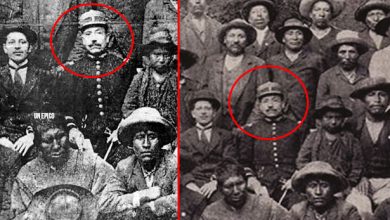Romance of Barbaracha by Luis Nieto

Cuzco’s women demand attention and Cuzco’s most famous poet of the twentieth century, Luis “El Cholo” Nieto Miranda gives it to them. His book, Charango: (Romancero Cholo) or “Charango (A Cholo Romance),” published in 1942, begins with a poem describing one of Cuzco’s women from his point of view as a man of his time and place. But she is more than a woman, she is the incarnation of the spirit of the cholos, a people of indigenous background who live in towns and cities, as a major portion of Peruvian identity. That poem Romance de la Barbaracha or Romance for Barbaracha is presented here in translation.
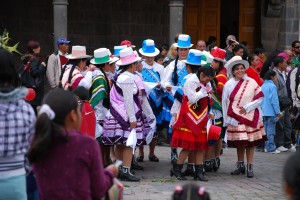
Romance for Barbaracha
Girl, I love you girl,
fresher than an apple,
with your wide skirt
and your percale blouse.
Your laugh shines cleanly
like frost’s crystal.
Your eyes light up impishly
like little morning stars.
The sun lifts from your lips.
The moon envies your face.
Your two braids seem to me
two snakes on your back.
This is how I like to see you
on my way to the plaza,
as with each step you make
all the women jealous.
I would love to be a raptor
to pierce you with my claw
and slice open on your breast
your two captive doves.
No one loves you like me,
saucy and cheeky girl
with your fourteen skirts
and your pure wool shawl.
______

I found you drinking,
all dressed up for a party
one sunday afternoon
of chicha and spicy food.
After the quick shot,
when you already had a buzz,
you asked for a tune from those
with charango, harp, and guitar.
And so with such pleasure
you sang your heart out,
it seemed you kept
a songbird in your throat.
______
Now let the dance come
well stepped and graceful,
let handkerchiefs explode
in white shaking.
–That is what’s good.
Go for it, Barbaracha.
How beautiful your eyes
shining like two coals!
How your laugh flames
until it ignites the party
and how your red skirts
shout with celebration.
Look at me, I am watching you.
Girl who never quits
beat your tattoo on my chest
with joy and with anger!
Hands burn the air
and glances shine.
Your drunken heart
opens like a pomegranate.
How the charango laughs.
How the guitar moans.
How your breasts jump
and your laughter bursts.
–Girl, girl, so hot, lift
your skirt a little; they say
your thighs are pinker than
dawn. I must see how you like
to shake your hips with fury. I want
to pillage them with my two
pirate hands!
Can’t you see that thirsty knives
shine in my eyes? How
I would like to bite you, girl
with your fierce look.
______
Though dancing all night, Barbaracha
kept on, drinking chicha
and rum till the strike of dawn.
After so much song her two
drunk doves slept jailed
under the green percale.
Luis Nieto Miranda
(Translated by David Knowlton)
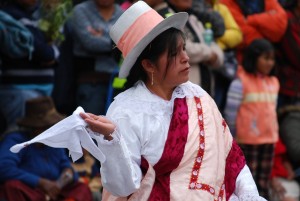
Translator’s Note
Translators must make choices. A poem is never the same in its original language as in English. For Barbaracha, this is evident from the first word.
I chose to render this word, “chola”, in English as “girl” while the other translation I have found (after I finished my own), one by Lynn Levin, kept the Spanish.
When the Spanish word is surrounded by English, as in Levin’s rendering, it takes something ordinary in Cusco –though located in the ongoing arguments of change and class — and puts it behind the romantic bars of a zoo of exotic human ways not our own.
There is merit to Levin’s approach. It insists on the location of the poem in Cuzco with its culture and demands that the reader go there while leaving their own way behind. Certainly this fits with Luís Nieto’s project of celebrating and justifying the cholo with a positive culture at a time when many works saw the cholos as untrustworthy, shifty, and negative since they were arguably Indians who did not stay in their place. Nieto properly exalts this urban Andean culture as legitimate.
Nevertheless, I chose to remove the exotic bars and free the poem by using the word “girl”. I did this because the word chola, or cholo, has become very general in Peru as a means of addressing anyone and everyone as a person, but a person who shares an identity with the speaker.
The specific dress that typified the chola and that Nieto describes in the poem when he talks about the twin braids hanging down Barbaracha’s back, or the multiple, pleated skirts (polleras), is increasingly not used other than for ceremonial occasions, especially the performance of dance and identity in Cuzco’s main square or on stage.
Instead, for most occasions women (and men) wear clothing indistinguishable from clothing in the US. I chose to emphasize this universality of style and identity by using the word “girl”.
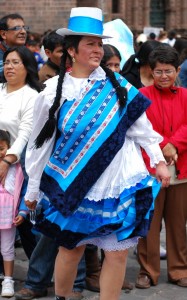
It is sexist. But Nieto’s poem, ensconced in the unquestioned and almost universal masculinity of the mid twentieth century, is unabashedly sexist. However, while describing Barbaracha from his male perspective with attraction and desire, unrequited craving to be sure, Nieto also picks up the classic Andean duality of male and female which is not simply the same as Western machismo.
Anthropologists generally describe the relationship between the sexes in the Andes as one of complementarity. That is they are different and dependent one on the other.
In the poem we see this most vividly in the way Barbaracha drinks and dances in the public space. She claims something other women may not have, especially traditional, Indigenous women who live in more separated domains. Claiming the space of masculinity, however, is a classic image of the chola, as Weismantel notes.
As the cholo identity has become less marked and more generalized and as the place of women in Hispanic Peruvian society has become more varied and open, women have claimed more and more spaces that formerly were uniquely male, or cholo. Barbaracha, therefore, comes to symbolize modern reality far more than is possible in the English had I chosen to keep the word chola, as ethnic and cultural marker, and as the first word of the poem.
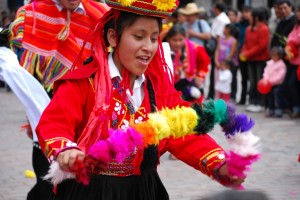
The poem is filled with other cultural references that I have chosen to universalize as well, such as the word huayno–which is an indigenous song style and which though widely performed today is increasingly assimilated to the Pan-Latin American cumbia when performed in popular dance venues. I translated it once as tune, which fits with the contemporary Cuzco slang “tonear” meaning to party, and once as “song.”
In today’s context the instruments are more likely to be a keybord and drum for a “tono” or party with music, drinking, and dance. Nevertheless, I chose to keep the classical cholo instruments referenced by Nieto which today are increasingly seens as “folkloric”, i.e. the charango, harp, and guitar.
We can also note that part of what justifies this poem being included in a blog on food culture is that it takes place mostly in a “picantería” one of Cuzco’s classic local-style restaurants at the same time that food and parties generally go together. Increasingly, though, the locale for such parties is a discotheque where food is much less present.
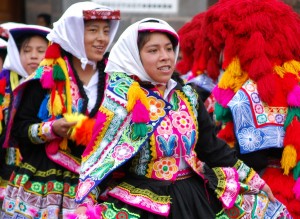
In the poem, as a result, I worked to find a balance which emphasized the universality of parties and a man looking at a woman with desire, without reducing it to an ethnic or exotic culture, all the while making sure that the local context is represented.
One place this combination of local and universal is strongly present is in the violent language in which Nieto’s speaker expresses his desire.
There is something of the frustrated, and perhaps slighted male in this to be sure. But there is also something very Andean. Part of the culture of complementarity is to see men and women’s relationships as separate and a matter of struggle, including struggle seen as potentially violent, though the violence is almost always contained. It does find its way into imagery, however.
Levin chose to remove most of this or tone it down when she rendered the poem in her English. Though I found the violent imagery very uncomfortable for me personally to the point it almost made me not want to translate the poem, I chose to leave it in the English version.
This after all is a poem of male longing and admiration from a time and place. I do not want to universalize that away, in a kind of forced political and cultural correctness. So it is still there in the direct and intimate way Nieto wrote it.
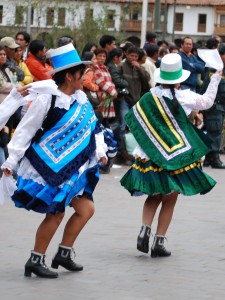
One other place where I left the local strongly there is in the title and the name of the central figure, Barbaracha. Her name is Barbara, just as in English, and I could have used that. But Nieto adds the Quechua suffix of enderament -cha that is not only widespread in local Cuzco Quechua but in its Spanish as well.
I struggled to find an English equivalent. But we simply do not modify names in this way. We can create nicknames that show endearment. But we do not use a prefix or a suffix to show that affect, and so I left the -cha. While in English this loses the linguistic play of emotion in the -cha and reduces the word to a simple name somehow similar and somehow different from Barbara, it at least is simple and acceptable. So there it stays.
After working through the poem and trying to render it in English while avoiding exoticism and yet still allowing cultural integrity, I have gained a greater appreciation for La Barbaracha as an important poem that even today speaks vividly to the experience of men and women in Cuzco.


